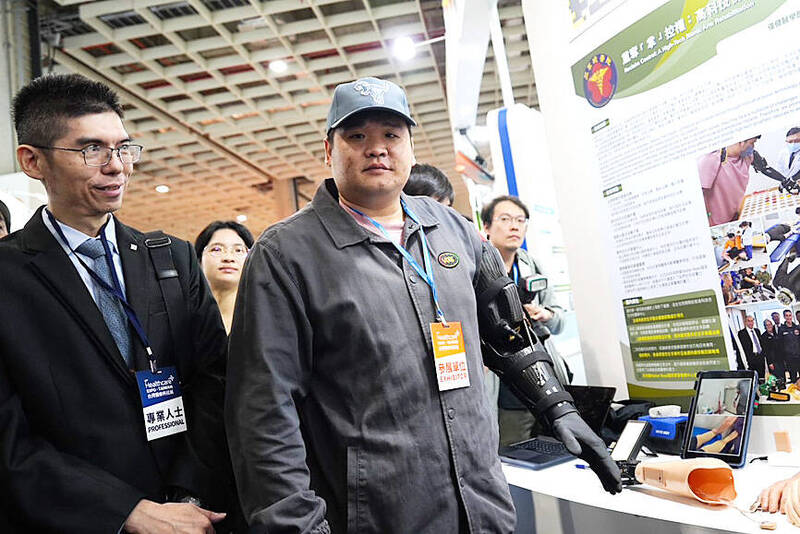《TAIPEI TIMES》 Soldier with bionic arm returns to duty, and life

Sergeant Hung, center, is pictured bionic arm at a medical technology expo at the Nangang Exhibition Center in Taipei on Dec. 5. Photo: CNA
By Jonathan Chin / Staff writer, with CNA
An army soldier fitted with a bionic left arm has returned to duty after last year losing a limb in an ammunition depot explosion in Kaohsiung.
The service member identified as Sergeant Hung (洪) can perform 14 types of fine motor functions with the cybernetic prosthetic, a Tri-Service General Hospital spokesperson said on Dec. 5 at a medical technology expo at the Nangang Exhibition Center.
The sergeant could use the prosthesis to shake hands, grasp objects and pull the trigger of a gun, allowing him to return to normal life and military service, they said.
Hung traveled to Japan, had fewer problems with daily life than before and was recently reinstated in the 6th Army Corps, he said, adding that Hung’s biggest post-bionic arm wish is hitting the gym and getting his muscles back.
In July last year, Hung was carrying out a technical inspection of 120mm mortar shells when one of the rounds detonated, wounding nine service members nearby.
Hung sustained heavy injuries to his left arm and right leg in the blast, and was showing no signs of life until doctors revived him at a care facility, a hospital spokesperson said. His arm was subsequently amputated.
Hung wore the prosthesis for a year and trained intensively for four months to achieve proficiency with the arm, they said, adding the artificial limb’s latency for trained users ranges from half a second to one second.
Chang Chih-ya (張智雅), head of the physical medicine and rehabilitation department, said the bionics program at the Tri-Service General Hospital stemmed from collaboration with Ottobock Co in Germany.
More than 30,000 people have lost limbs in the ongoing Russian invasion of Ukraine, spurring the development of artificial limbs with improved functionality, he said.
The two institutions created the cybernetic arm and rehabilitation regimen used to restore Hung’s arm, he said.
The bionic arm uses sensors to read electronic signals sent by the nerve endings of the stump, enabling a trained user to manipulate the artificial limb at will, he said.
The life-like contours are designed to be more aesthetically pleasing and reduce disruption to social life, Chang said.
Tu Lien-shui, director of Taiwan O and P Co, one of the project’s corporate partners, said the next step in cybernetics is to utilize implant technology to increase precision and responsivity.
The hospital and its partners are also working on 3D printers to make bionic prostheses more affordable, he added.
新聞來源:TAIPEI TIMES














